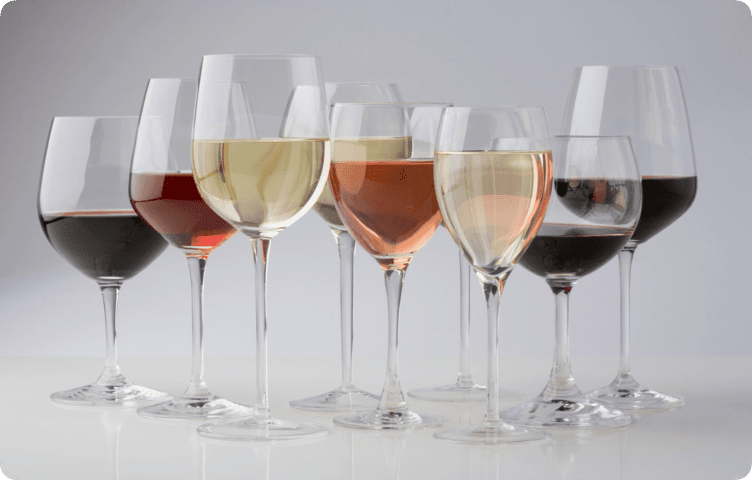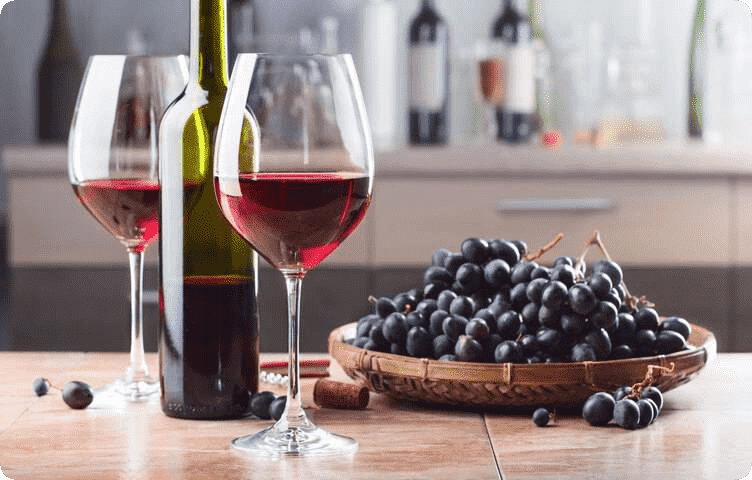If you don't know much about wine, the variety of bottles in stores and restaurant menus will confuse you. How to choose this exquisite alcohol - by color, grape variety or year of production? Information about the main types of drink and how to prepare it will help you find a product that suits your taste.
Classification by color
The basis for wine production is fermented grape juice. It is the color of the berries that affects the taste, aroma and aftertaste of the drink. Winemakers use two types of grapes - white, which actually has a green tint, and black, which actually has a red tint. Within these two categories, there are hundreds of varieties used in winemaking.

White wines
They are made from both light and black grapes. The main feature is the removal of the skin, due to which the finished drink acquires a light shade and transparency. The product is aged in stainless steel barrels to maintain a fresh scent. Aging in oak containers gives the aroma notes of vanilla, coconut or caramel.
An important characteristic of the drink is aroma. Fragrant grape varieties have a pronounced floral trail, as well as notes of fruit - peach, apricot, apple, pear.
The taste and smell of the product depends on the climate of the wine-growing regions. In warm countries, the product acquires the aromas of tropical fruits: guava, passion fruit, pineapple. In areas with a cool climate, citrus scents predominate.
The most popular drink options:
- chardonnay;
- sauvignon blanc;
- pinot grigio;
- Riesling.
White varieties have few tannins, so their taste is fresh and slightly astringent. It harmonizes with light dishes: poultry, fish, seafood, cheeses and rice side dishes. To maximize the characteristics of the drink, it is cooled before drinking.
Red wines
When black grapes are fermented along with their skins, seeds and stems, the resulting liquid is dark red in color. The product contains a large amount of tannins, which create a bitter taste.
These substances act as a preservative, which is why red wines age longer than white wines. Thanks to this, the structure of the drink improves and the taste becomes softer. Oak barrels are used for aging, imparting the taste and aroma of cinnamon, cocoa, chocolate and vanilla.
The taste and aromas depend on the grape variety and the aging method. In warm countries, the wort acquires flavors of red and black berries: strawberries, raspberries, cherries, cherries, blackberries. The product, produced in a temperate climate, has a herbaceous aroma.
The most popular all over the world are:
- cabernet sauvignon;
- merlot;
- Beaujolais;
- pinot noir;
- Chianti.
They go well with hot red meat dishes: kebabs, steaks, pasta with meat sauce. Gourmets drink the drink at room temperature, as cooling enhances the bitter taste of tannins.
Rose wines
The raw material for them is red grapes. But the skins are removed from the wort in less than a day. It manages to give the fermented juice a pink color, but releases too many tannins. Products in this category are necessarily labeled with the French word Rosé.
Pink varieties have a light sweet taste with hints of strawberries, cherries, raspberries, and citrus fruits. They go well with light poultry and fish dishes, cheeses, and fruits.
Classification of wines based on residual sugar
An important criterion for wine products is the amount of sugar remaining after fermentation. This indicator is designated RS and is measured as a percentage. It helps you understand how sweet the drink will be. Sugar is not the only factor that determines the level of sweetness. The taste also depends on the alcohol content, acidity and volume of tannins.
Sweet
Grapes of all varieties contain many carbohydrates, including fructose and glucose, which stimulate the fermentation process. Some types of sugars do not break down, maintaining a sweet taste even in dry wine.
If the volume of residual sugar remains 5% or more, the product is considered sweet. It has an intense fruity flavor and aroma. Different varieties can be sweet: red, white, pink. The most popular of them:
- nutmeg;
- white zinfandel;
- Riesling;
- Sauternes;
- port wine;
- sherry.
Sweet wines go well with fried chicken, red meat, seafood, and cheese. Experts believe that the sweetness of alcohol favorably emphasizes the spiciness of Thai and Korean dishes.
Semi-dry
If the residual sugar content is between 0.5% and 1.49%, the drink is consideredappears semi-dry. Products in this category are distinguished by light sweetness and a noticeable fruity flavor. The strength is quite high - from 10% to 15%.
The best examples of semi-dry wines are produced in France, Italy, and South Africa. Winemakers in these countries most often use Chenin Blanc or Chardonnay grapes, which contain less natural sugars.
Semi-dry varieties have a floral, almond or herbal flavor. Fruit flavors are dominated by apple and citrus.
Examples of semi-dry wine:
- sauvignon blanc;
- pinot grigio;
- Riesling;
- chardonnay;
- Gewürztraminer.
These drinks are in harmony with pork, chicken, Indian and Thai dishes.
Semi-sweet
Semi-sweet is a wine containing from 1.5% to 4.9% residual sugar. Sweetness and acidity are perfectly balanced, the taste is pleasantly soft. Thanks to this, semi-sweet alcohol is often chosen for various feasts: from everyday dinners to formal banquets.
The most famous varieties:
- Bordeaux;
- Riesling;
- Chianti;
- Burgundy;
- cabernet franc
Semi-sweet drinks are consumed slightly chilled. They taste harmoniously with fish, fried meat and spicy dishes.
Dry
When grape juice is fermented, the yeast absorbs the natural sugars. As a result, alcohol is formed. If the winemaker allows the process to complete, only sugars that cannot be fermented remain in the wort. This product is called dry wine. Its sweetness level does not exceed 0.5%.
Dry red wine has almost no sweet taste. Increased levels of acidity and tannins cause a dry sensation on the tongue and a slight tingling sensation in the mouth. Bordeaux, Cabernet Sauvignon, Merlot, Burgundy and Zinfandel have such properties. They go well with smoked meat, fish, fried vegetables and mushrooms.
Dry white wine has a sweet aroma with pronounced fruity notes, but there is no real sweetness in it. Most drinks in this category have an astringent taste. The most famous dry white varieties are Chardonnay, Sauvignon Blanc, and Pinot Grigio. They are usually served with baked fish and vegetables.
By grape variety

The product is also classified according to the type of raw material from which it is produced. There are special varieties of grapes that are not eaten like regular fruits. They are grown exclusively for the needs of the wine industry. Unique wine styles have been formed based on popular varieties.
Chardonnay
This is the name of the Burgundy grape, from which dry white and sparkling wines are produced. They were originally produced in France, and are now also produced in Germany, the USA, Australia and South Africa. When aged in oak barrels, Chardonnay takes on the spicy notes of bourbon. Lightly aged products are distinguished by the taste of apples and citrus fruits.
Cabernet Sauvignon
This variety was first received by Bordeaux winegrowers. Dry red wines with a high content of alcohol and tannins are prepared from it. The rich taste of cabernet combines notes of vanilla, black currant, cherry and cedar. The product is considered the most popular variety in the world. Usually served with red meat, smoked meats and hard cheeses.
Merlot
The name of the variety comes from the French red grape. It produces dry red wine with medium to high alcohol levels and soft tannins. Merlot has received the nickname “chameleon” for its rich range of taste. Its flavor profile contains dozens of shades: blackberry, cherry, plum, wild herbs. Aging in oak barrels develops aromas of vanilla, cloves and cedar.
Merlot is served slightly chilled. Gourmets believe that its taste goes well with different types of meat, duck, mushrooms, bean dishes and pizza.
Sauvignon Blanc
Initially, this was the name of a variety of white French grapes. It serves as a raw material for the production of dry wines of medium strength. They are distinguished by a tart herbaceous taste with notes of citrus fruits, melon, and kiwi. Sauvignon Blanc is traditionally served with French, Mexican and Vietnamese cuisine. The sour-tart taste complements fried meat, poultry, and cheeses well.
According to the place of origin
Countries famous for their developed winemaking have their own wine classifications. They are based on the place of production of the drink - from the country as a whole to an individual farm.
A common European system has also been adopted, consisting of three categories:
AOR is alcohol of the highest quality, produced in the famous wine-making region, in accordance with established technologies and traditions;
IGP – products of any locality, incompleteis in compliance with the law. The bottles indicate the region and grape variety;
Uncategorized - ordinary table wine.
Outside Europe, classification by place of origin is not used.
By exposure

Chemical processes continue in a sealed bottle. Upon contact with oxygen through the cork, oxidation occurs, due to which the product “ripens”. Therefore, quality is often determined by the degree of aging:
Young - recently bottled. It is distinguished by a light shade, sour taste and high level of tannins;
Unaged - produced from wort in which the fermentation process has not been completed;
Aged – bottled at least 6 months ago. It has a mild taste with less pronounced bitterness and rich color;
Vintage - aged in barrels for 1.5 years, then stored in bottles for 3-4 years;
Collectible – distinguished by aging for over 5 years, of which at least 2 years in barrels.
The maximum shelf life of collection drinks is considered to be 70 years, although in the history of winemaking there are cases of preservation of quality during storage for more than 200 years.
What to look for when choosing wine
The first thing you should rely on is your own taste preferences. Here are five criteria that will help you understand the drink without opening the bottle:
Sweetness – The label indicates the term “sweet,” “semi-sweet,” or “dry.” The last option is not recommended for beginners;
Color – white and rosé wines have a milder taste;
Alcohol content - the indicator can vary from 5.5% to 20%. For beginners, it is better to choose the middle range – 11-13%;
Taste preferences – it has been noticed that black coffee lovers prefer dry wines produced in Europe. Those who love cappuccino and lattes prefer sweet varieties from Australia, the USA, and South Africa;
Combinations – consider what dishes you will serve the drink with.
Read the label carefully - it indicates the acidity level, sugar and tannin content, and sometimes aroma characteristics.
















































/https%3A%2F%2Fcomplexbar.com%2Fimages%2Fblog%2F132%2FWine1-2.png)
/https%3A%2F%2Fcomplexbar.com%2Fimages%2Fblog%2F246%2Fsirop_scale_2400.jpeg)
/https%3A%2F%2Fcomplexbar.com%2Fimages%2Fblog%2F246%2Fkofe-vostochniy.jpg)
/https%3A%2F%2Fcomplexbar.com%2Fimages%2Fblog%2F245%2Fpexels-jason-villanueva-851555.jpg)
/https%3A%2F%2Fcomplexbar.com%2Fimages%2Fblog%2F246%2F2024-04-09_17.22.54.jpg)
/https%3A%2F%2Fcomplexbar.com%2Fimages%2Fblog%2F246%2F2024-04-09_17.22.47.jpg)
/https%3A%2F%2Fcomplexbar.com%2Fimages%2Fblog%2F246%2FCODE_anons_foamydrops_752%D1%85480_eng.jpg)
/https%3A%2F%2Fcomplexbar.com%2Fimages%2Fblog%2F246%2FAlina_752%D1%85480_eng.jpg)
/https%3A%2F%2Fcomplexbar.com%2Fimages%2Fblog%2F246%2F2024-04-09_17.23.22.jpg)
/https%3A%2F%2Fcomplexbar.com%2Fimages%2Fblog%2F246%2F2024-04-09_17.23.28.jpg)
/https%3A%2F%2Fcomplexbar.com%2Fimages%2Fblog%2F246%2F2024-04-09_17.23.35.jpg)
/https%3A%2F%2Fcomplexbar.com%2Fimages%2Fblog%2F246%2Fdrinksome_752%D1%85480_eng.jpg)
/https%3A%2F%2Fcomplexbar.com%2Fimages%2Fblog%2F246%2Fnude_752%D1%85480_eng.jpg)
/https%3A%2F%2Fcomplexbar.com%2Fimages%2Fblog%2F246%2F752%D1%85480_eng__1_.jpg)
/https%3A%2F%2Fcomplexbar.com%2Fimages%2Fblog%2F246%2F752%D1%85480_eng.jpg)
/https%3A%2F%2Fcomplexbar.com%2Fimages%2Fblog%2F246%2FStudioRaw_752%D1%85480_eng.jpg)
/https%3A%2F%2Fcomplexbar.com%2Fimages%2Fblog%2F246%2FDoppio_tea_752%D1%85480_eng.jpg)
/https%3A%2F%2Fcomplexbar.com%2Fimages%2Fblog%2F246%2FTognana_Stars_Stripes_752%D1%85480_eng.jpg)
/https%3A%2F%2Fcomplexbar.com%2Fimages%2Fblog%2F246%2FRona_752%D1%85480_eng.jpg)
/https%3A%2F%2Fcomplexbar.com%2Fimages%2Fblog%2F246%2FDoppio_vending_752%D1%85480_eng.jpg)
/https%3A%2F%2Fcomplexbar.com%2Fimages%2Fblog%2F246%2FEssence_sukhie_smesi_752%D1%85480_eng.jpg)
/https%3A%2F%2Fcomplexbar.com%2Fimages%2Fblog%2F246%2FODK_sukhie_smesi752%D1%85480_eng.jpg)
/https%3A%2F%2Fcomplexbar.com%2Fimages%2Fblog%2F246%2Funiforma-barmena.jpg)
/https%3A%2F%2Fcomplexbar.com%2Fimages%2Fblog%2F246%2Fkak-nanyat-barmena.jpg)
/https%3A%2F%2Fcomplexbar.com%2Fimages%2Fblog%2F246%2Fsirop_scale_2400.jpeg)
/https%3A%2F%2Fcomplexbar.com%2Fimages%2Fblog%2F246%2FPeugeot_Anons_Paris_U%27Select_Line_Daman_752%D1%85480_eng.jpg)
/https%3A%2F%2Fcomplexbar.com%2Fimages%2Fblog%2F246%2Fkofe-vostochniy.jpg)
/https%3A%2F%2Fcomplexbar.com%2Fimages%2Fblog%2F246%2FMadler.jpg)
/https%3A%2F%2Fcomplexbar.com%2Fimages%2Fblog%2F246%2Fprofbartender_glavn.jpeg)